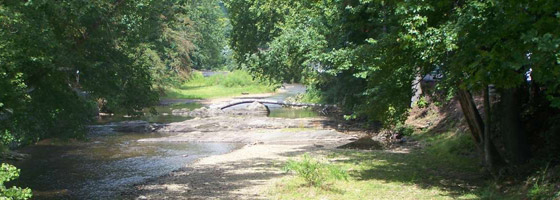Water Quality Detection Systems Powered by YSI Sondes

Reprinted: YSI Incorporated
ALABAMA: Intake Station upgrades to Multiparameter Monitoring Equipment
In Birmingham, at the Mulberry Intake Station, raw water is pumped from the Black Warrior River and transported 22 miles downstream to the Water Works Filtration Plant for treatment. Greg Henslee, Pump Station Supervisor, wanted to upgrade his water quality detection system from single parameter monitoring equipment to multiparameter monitoring equipment that would continuously monitor and work in a 4- 20 mA environment. Henslee had been using three separate instruments; a pH instrument in sampling mode, and DO and turbidity instruments in continuous mode.
Now, the YSI 6820 sonde monitors all these parameters simultaneously. The YSI 6820 sonde is configured to continuously monitor DO, conductivity, temperature, pH, and turbidity, but could measure more than 15 parameters simultaneously. Additionally he is using the YSI 6500 Environmental Process Monitor to convert the digital signal from the YSI 6820 sonde to an analog signal which is then tied into their plant SCADA system. Henslee can now monitor the results from his office and based on changes in water quality, can make decisions on whether or not to pump water from the Mulberry intake or another intake.
WYOMING: Source Water Fluctuations Tracked Long-term
The City of Cheyenne, Wyoming wanted to collect long-term trend data to track and record fluctuations in their source water. Previously, someone had to drive twenty miles from the plant building to the intake site once a week to collect spot data. “Now I can pull up real-time data from twenty miles away,” said Lab Coordinator Rosie Pindilli. Cheyenne uses a YSI 6500 Environmental Process Monitor and a YSI 6920 sonde in conjunction with its SCADA system. Suspended in the lake, the sonde measures pH, dissolved oxygen, conductivity, turbidity, and temperature at the bottom of the dam. Lab personnel can read real-time data as oft en as once a minute from the front of the environmental process monitor, which has a large clear display; or they have the option to view the data from the SCADA system or a PC.
The monitor’s four scalable relays can drive several functions including alarm indicators such as lamps, horns, or an automatic phone dialer system that are activated at user-defined set points. The Cheyenne treatment plant uses maximum or minimum values for all five parameters to trigger its alarms.
GEORGIA: Source Water Assessment and Protection
The Columbus Water Works has initiated a regional watershed program involving both water quality detection and drinking water protection. The source water protection program element of the Middle Chattahoochee River Watershed Study is a demonstration program supported by the Georgia Environmental Protection Division (EPD), the Alabama Department of Environmental Management (ADEM) and the US EPA. The Middle Chattahoochee River from West Point Lake Dam to North Highlands Dam in Columbus serves as the major source for drinking water in the region. As an interstate demonstration program and an element of a broader watershed project, the scope of activities in this study goes beyond the minimum requirements of the EPD’s Source Water Protection guidance.
Two elements of the Columbus Source Water Protection Program include a source water quality detection system and subwatershed and river monitoring. Monitoring includes rainfall/ runoff, sampling for suspended solids, organics, nutrients, metals, bacteria, Cryptosporidium and Giardia; quarterly invertebrates and biannual fish; river and lake bathymetry; and lake plume movements. YSI multiparameter equipment is being used for continuous monitoring of turbidity, conductivity, ORP, dissolved oxygen, temperature and pH.
TEXAS: Saline Water Study: Edwards Aquifer
The Edwards aquifer is a valuable water source for the residents of eight Texas counties. The Edwards aquifer extends eastward from Bracketville, Texas, in Kinney County, approximately 176 miles to Kyle, Texas, in Hays County (The City of Kyle is located approximately 30 miles south of Austin, Texas). The City of San Antonio, Texas is the largest municipality situated over the Edwards Aquifer. An average of 304,000 acrefeet of water is pumped annually from the aquifer for ranching, farming, municipal, and industrial purposes. Another 364,000 acre-feet of natural recharge is discharged annually from springs which supply downstream flow to several south Texas rivers. The Edwards Aquifer is comprised of both fresh and saline waters. The interface between the two “portions” (fresh and saline waters) has become known locally as the “bad water line.”
This interface is defined by the mineral concentrations of the waters, measured as total dissolved solids (TDS) concentrations of 1000 mg/l, with TDS and conductivity readings increasing south of the interface. The San Antonio Water System (SAWS) is heading a program to determine how the fresh and saline waters in the Edwards Aquifer interact, and whether encroachment of saline water into the fresh water portion of the aquifer might occur during periods of extended drought. The Saline Water Study will provide data from a monitoring network necessary to answer many of the questions and concerns regarding how the freshwater/saline-water interface of the Edwards Aquifer functions.
SAWS has utilized a YSI 600R sonde during monitor well purging to characterize water quality (conductivity, pH, and temperature). The parameters are displayed on a YSI 650 handheld display and recorded manually into a field log book. The YSI 600R sonde is placed in a flow through chamber and connected to the YSI 650. A stream of water pumped from the well is diverted through the flow chamber for water quality characterization. Dissolved oxygen is also measured utilizing a YSI 85 handheld instrument and a flow cell chamber. SAWS has also received a quotation from YSI for a specially designed YSI 600XLM sonde. The sonde will be designed to collect in-situ water quality readings while withstanding pressures encountered at up to 800 ft of submergence. The in situ data collected from selected monitoring wells will provide a better understanding of flow paths through various sections of both the fresh and saline portions of the aquifer for a more well-rounded water quality detection system.
Image Credit: NOAA




0 comments